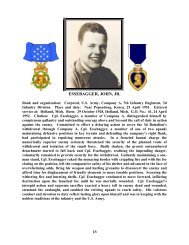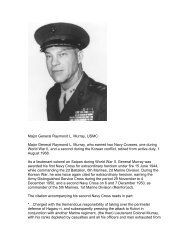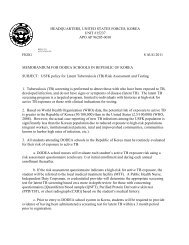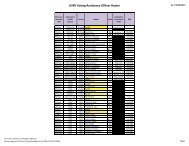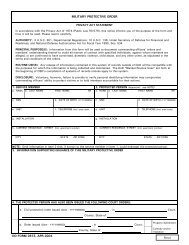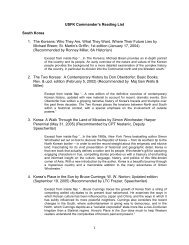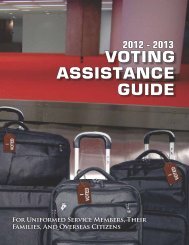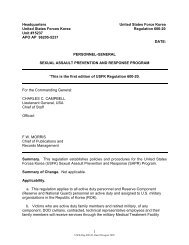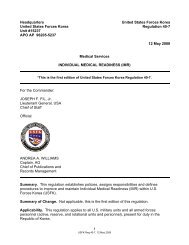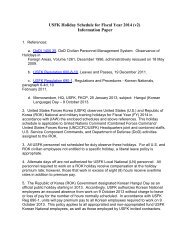Curtis Utz, Assault from the Sea, The Amphibious Landing, Naval ...
Curtis Utz, Assault from the Sea, The Amphibious Landing, Naval ...
Curtis Utz, Assault from the Sea, The Amphibious Landing, Naval ...
You also want an ePaper? Increase the reach of your titles
YUMPU automatically turns print PDFs into web optimized ePapers that Google loves.
stroyers would steam into <strong>the</strong><br />
harbor to shell Wolmi Do and<br />
check <strong>the</strong> waters for mines.<br />
Even though <strong>the</strong> Japanese<br />
and American tide tables<br />
did not agree, planners estimated<br />
that high tides would<br />
occur shortly after sunrise<br />
and <strong>the</strong>n just after sunset<br />
on 15 September. Since most<br />
of <strong>the</strong> amphibious ships would<br />
need daylight to navigate<br />
<strong>the</strong> narrow, swift waters of<br />
Flying Fish Channel and <strong>the</strong><br />
Salee River, <strong>the</strong> planners<br />
decided that <strong>the</strong> smaller<br />
initial landing would take<br />
place on <strong>the</strong> morning tide. A<br />
reinforced Marine battalion<br />
would storm ashore at Green<br />
Beach on Wolmi Do and<br />
seize this island that dominated<br />
<strong>the</strong> harbor. With close<br />
air and naval gunfire support,<br />
<strong>the</strong> unit was expected to<br />
hold off any North Korean<br />
counterattacks during <strong>the</strong><br />
day. <strong>The</strong> main assault would<br />
occur as <strong>the</strong> tide rose in <strong>the</strong><br />
evening. Two Marine battalions<br />
would land at Red Beach,<br />
just north of <strong>the</strong> causeway<br />
<strong>from</strong> Wolmi Do, and seize<br />
<strong>the</strong> three hills in town. An<br />
entire Marine regiment<br />
would land at Blue Beach,<br />
three miles to <strong>the</strong> south of<br />
Red Beach.<br />
Both “beaches” were in actuality<br />
built-up industrial<br />
areas largely bounded by<br />
sea walls. Vehicle and personnel<br />
landing craft (LCVP)<br />
and medium landing craft<br />
(LCM) were responsible for<br />
deploying <strong>the</strong> lea<strong>the</strong>rnecks<br />
to shore at Red Beach.<br />
Tracked landing vehicles<br />
(LVT), also known as amtracs,<br />
would transport <strong>the</strong> Marines<br />
in <strong>the</strong> first waves at Blue<br />
Beach, because <strong>the</strong> approach<br />
crossed two miles of mud<br />
flats covered by shallow<br />
water. LCVPs would bring<br />
in <strong>the</strong> rest of <strong>the</strong> regiment<br />
in later waves. Navy and<br />
Marine planners concluded<br />
that both beachheads were<br />
defensible, even though<br />
separated by <strong>the</strong> built-up<br />
section of Inchon.<br />
<strong>The</strong> planners paid special<br />
attention to logistics support,<br />
which would be vital to <strong>the</strong><br />
success of not only <strong>the</strong> initial<br />
assault on Inchon but <strong>the</strong><br />
breakout to Seoul. <strong>The</strong>y<br />
knew that <strong>the</strong> existing port<br />
facilities were rudimentary<br />
and even those would probably<br />
be destroyed in combat.<br />
Initially, all material would<br />
have to be moved across <strong>the</strong><br />
beach. In addition, <strong>the</strong> narrow<br />
approaches <strong>from</strong> <strong>the</strong> sea<br />
would allow only a few ships<br />
at a time to operate off<br />
Inchon.<br />
<strong>The</strong> Navy’s LSTs, which<br />
were designed to operate in<br />
shallow water and unload<br />
cargo directly onto <strong>the</strong> beach,<br />
were key to success at Inchon.<br />
Doyle assembled 17 U.S.<br />
Navy LSTs and 30 Japanesemanned<br />
SCAJAP vessels.<br />
<strong>The</strong> admiral, understanding<br />
<strong>the</strong> importance of keeping<br />
<strong>the</strong> Marines supplied with<br />
ammunition and equipment<br />
in <strong>the</strong> early, critical stage of<br />
<strong>the</strong> landing, planned to leave<br />
some of his LSTs aground as<br />
<strong>the</strong> evening tide receded.<br />
<strong>The</strong>y would be replaced by<br />
o<strong>the</strong>r ships with <strong>the</strong> following<br />
morning’s tide. Hence,<br />
<strong>the</strong> LSTs, which in World<br />
War II were often referred<br />
to by <strong>the</strong>ir crews as “large,<br />
slow targets,” would in this<br />
instance be “large, stationary<br />
targets.”<br />
<strong>The</strong> planners knew that<br />
accurate intelligence was<br />
critical to <strong>the</strong> success of an<br />
operation as complex as an<br />
amphibious assault. Consequently,<br />
in late August, <strong>the</strong><br />
FECOM acted to ga<strong>the</strong>r more<br />
information about <strong>the</strong> waterways<br />
leading to Inchon. On<br />
19 August, <strong>the</strong> Canadian destroyer<br />
HMCS Athabaskan<br />
(DDE 219) escorted a ROK<br />
navy vessel to Yonghung Do,<br />
an island only 14 miles <strong>from</strong><br />
Inchon. Lieutenant Commander<br />
Ham Myong Su led<br />
a small team ashore where<br />
<strong>the</strong>y found <strong>the</strong> inhabitants<br />
sympa<strong>the</strong>tic to <strong>the</strong> South<br />
Korean cause. Armed with<br />
this information, on 1 September<br />
FECOM dispatched<br />
to <strong>the</strong> island Navy Lieutenant<br />
Eugene F. Clark, a former<br />
LST skipper. Under <strong>the</strong> noses<br />
of nearby NKPA island garrisons,<br />
Clark’s team ga<strong>the</strong>red<br />
information on surrounding<br />
waterways. <strong>The</strong> lieutenant<br />
informed Tokyo that <strong>the</strong><br />
Japanese tide tables were<br />
accurate, <strong>the</strong> area’s mud flats<br />
would support no weight, sea<br />
walls were higher than estimated<br />
and Wolmi Do was<br />
heavily fortified and bristled<br />
with numerous artillery<br />
pieces. Clark reported that<br />
even though <strong>the</strong> Canadians<br />
had disabled Palmi Do lighthouse,<br />
it was easily repairable.<br />
Tokyo told <strong>the</strong> intrepid officer<br />
to relight <strong>the</strong> beacon just after<br />
midnight on 15 September.<br />
19



